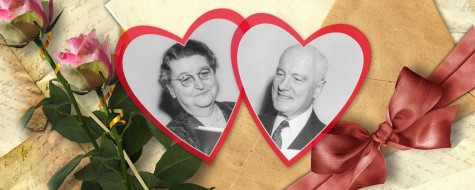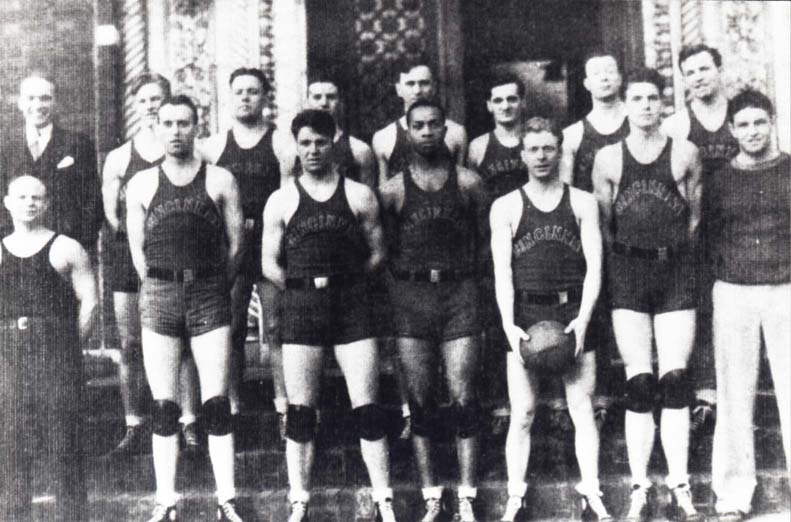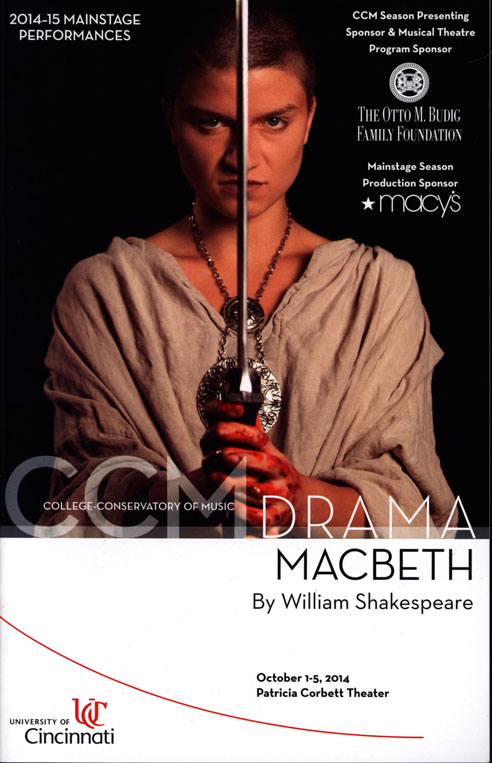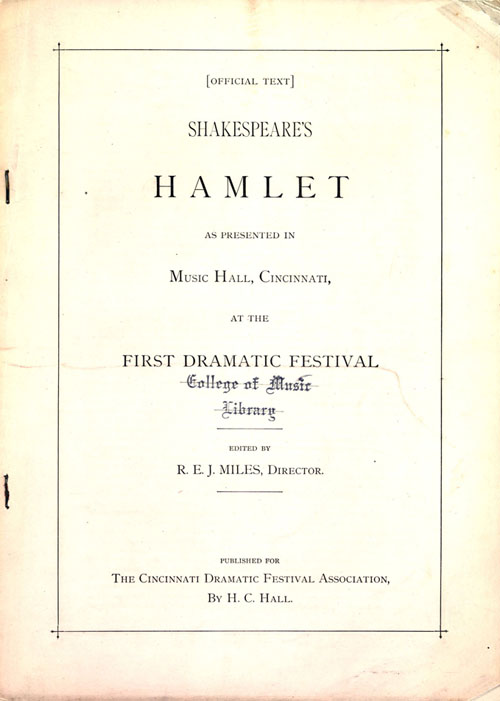The final day of LOVE YOUR DATA week and it all comes together. Well documented and organized data kept safe and shared with researchers continue the scientific conversations. A brilliant example of this is the Human Genome Project. This 13-year project funded by public and private efforts opened access to genetic data that led to the discovery of 1800 disease genes and over 2000 tests for human conditions. Countless research projects can get off the ground because their time and resources can focus on next steps instead of reinventing the already sequenced wheel. What is really going on is DATA REUSE.
Category Archives: ARB Library
LOVE YOUR DATA Day 4 – Data Shhharing
Post by Tiffany Grant PhD, Research Informationist based at Donald C. Harrison Health Sciences Library
Data Shhharing
“Data” and “sharing” are two words that we don’t like to juxtapose in the scientific community. I mean, who wants to share their hard earned data? It’s the equivalent of sharing ones salary with the world- a group of strangers. The data generated via the scientific process is extremely personal, and is intrinsic to the life and legacy of the researchers who create it. Researchers don’t have a problem with publishing their work once completed, as it adds to their scientific credibility. But, therein lies the problem. Publication does not always equal access.
It is the publisher, not the researcher who owns the rights to the articles published in their journals. Access to these journals typically only comes through a paid subscription. So, while researchers can often get access to journals through their institution, access is not granted to all without paying for individual articles at a time, a process which can prove quite costly. Thus paying for access to online content makes sense only to publishers who profit from it. But, as a researcher, do you really want your hard work under this veil? Is that really what you worked for?
LOVE YOUR DATA Day 3 – Data Documentation
I say to you….slow down, smell the agar plates, take the time to document your data. Your future self will thank you, profusely.
Proper documentation provides the context that your data needs to persist through time, to integrate into new systems and to give you credit for your contributions in the form of data citations. Where possible, you should consider contributing the following information along with your dataset.
Presidential Love Notes
Diaries reveal former UC President Raymond Walters’ love and admiration for his longtime Valentine
By: Dawn Fuller

President and Mrs. Raymond Walters hold a special souvenir edition of The News Record, presented to the couple at the president’s student-sponsored retirement dinner in 1955.
Her name was Elsie, but her husband, UC’s longest-running president, called her “BobOLink,” which is also the name of a songbird. Throughout their 46-year marriage, Raymond Walters remained charmed and fascinated by his wife, as passages reveal in his diaries, which were donated to UC’s Archives and Rare Books Library.
Walters served as president of UC for 23 years, from 1932-1955. The diaries hold daily activities and thoughts of President Walters over the decades, from 1925-1960, and as a result reveal decades of history, including the history of UC. But the diaries also lovingly reveal Valentine gifts, wedding anniversaries and tributes to his wife. Continue reading
LOVE YOUR DATA Day 2 – Organizing your data
Post by Tiffany Grant PhD, Research Informationist based at Donald C. Harrison Health Sciences Library
Organizing Data
When you’re generating data at a rapid pace, it can be easy to label files with names that seem good at the time, but that will have very little meaning to you later. This practice may save time in the present, but it will ultimately lead to great frustration in the future when finding these exact files seem nearly impossible.
A good practice for data organization is to give your files meaningful, descriptive names, but avoiding long file names. Files names should allow you to identify a precise experiment from the name.
How meaningful are the following file names?
- Test_data_2013
- Project_Data
- Design for project.doc
- Lab_work_Eric
- Second_test
- Meeting Notes Oct 23
LOVE YOUR DATA Day 1 – Keep your data safe
Let’s kick off LOVE YOUR DATA week with KEEPING DATA SAFE.
First a sad story – in one of my first Top Ten Tips for Data Management workshops, I had a workshop participant who I thought was bored out of his skull. He had a glazed look in his eyes and kept shaking his head as if he was saying no, no, no. I approached him, though with some reservations after the workshop, and asked what he thought about the topic and my presentation. His words and I quote were “if only I had known this 6 months ago…I just lost my dissertation work and I am still getting over the shock”. Not bored, but in shock. He had lost 6 months’ worth of work. Sadly he is not the first. If only he and others had known about 3-2-1 or Here-Near and Far.
3-2-1 stands for
3 copies (1 primary copy and two backup copies of your data)
2 formats for storage (use a computer hard drive and an external hard drive)
1 remote copy (cloud storage or geographically separate from your other copies)
These three tips will help keep your data safe and protect your valuable time.
Here, Near and Far is another way of thinking about the same tips. Set up an automatic back up for your data to make it even easier.
At UC we have a few tools that can help you back up your data:
1) Use your Box account. You have 50 GB available to you. IT@UC also has other data solutions available.
2) You can track your work with the Open Science Framework developed by the Center for Open Science or use GitHub.
3) Attend a data management workshop offered by UC Libraries. We have several coming up particular a workshop called Managing Research Data from Generation to Preservation on April 19th.
Fun Fact: Did you know we can still look at Darwin’s original notebooks through the Darwin Online project. Someone took extra special care for those files. Let’s do the same for your data.
Check out this fun video about data back-up and learn how the movie Toy Story 2 was almost lost, but was saved by the 3-2-1 rule.
Visit the Love your Data website for more tips to help keep your data safe. Follow the event on Twitter at #LYD16.
Shake it Up with Shakespeare This Weekend!
By: Sydney Vollmer
 So what are you doing tonight? Tomorrow night? This weekend? Maybe you’ve already got your next few days filled up. That’s okay, because the Cincinnati Shakespeare Company will still have showings of Henry VI: The Wars of the Roses, Part 1 up through February 13th! (And no, it doesn’t have anything to do with the cheating game on KISS107 in the mornings). This show is all about actual war. Continue reading
So what are you doing tonight? Tomorrow night? This weekend? Maybe you’ve already got your next few days filled up. That’s okay, because the Cincinnati Shakespeare Company will still have showings of Henry VI: The Wars of the Roses, Part 1 up through February 13th! (And no, it doesn’t have anything to do with the cheating game on KISS107 in the mornings). This show is all about actual war. Continue reading
Darth Vader, WTFeth, Man?
By: Sydney Vollmer, ARB Intern
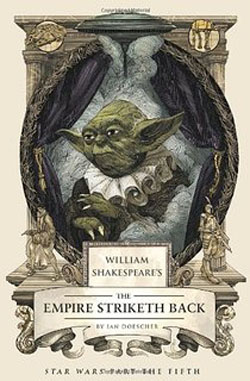 A brief moment ago, in a galaxy that is our own, Shakespeare has been reimagined. It is a time of artistic freedom and a lack of brand new ideas. Authors left and right are taking popular works and translating them into Shakespeare’s style. The remaining few are taking Shakespeare’s works and translating them into modern texts, literally. Star Wars is an empire that has befallen this fate. Iambic pentameter maketh Yoda sound yet wiser, and Han Solo a fairer knave. Thank thee Maker! Forsooth, never before have two groups with such extreme cult followings come together to create a new work! Shakespeare lovers and Star Wars fans alike can now come together. Continue reading
A brief moment ago, in a galaxy that is our own, Shakespeare has been reimagined. It is a time of artistic freedom and a lack of brand new ideas. Authors left and right are taking popular works and translating them into Shakespeare’s style. The remaining few are taking Shakespeare’s works and translating them into modern texts, literally. Star Wars is an empire that has befallen this fate. Iambic pentameter maketh Yoda sound yet wiser, and Han Solo a fairer knave. Thank thee Maker! Forsooth, never before have two groups with such extreme cult followings come together to create a new work! Shakespeare lovers and Star Wars fans alike can now come together. Continue reading
African American History Month and the Archives & Rare Books Library
By: Kevin Grace
It is February again, a month notable for honoring presidents and for looking forward to spring. February is also a time when we reflect on the heritage of African Americans in the United States and take time to acknowledge that part of our nation’s history.
Depending on the media, we also term February as Black History Month, and it had its beginnings in 1926 when “Negro History Week” was created by historian Carter G. Woodson. Woodson’s intent was to celebrate it in February because both Abraham Lincoln and Frederick Douglass had their birthdays in this month., and as he stated, “If a race has no history, it has no worthwhile tradition, it becomes a negligible factor in the thought of the world, and it stands in danger of being exterminated.” Continue reading
A Program By Any Name: Calling All Theater Goers and Performers!
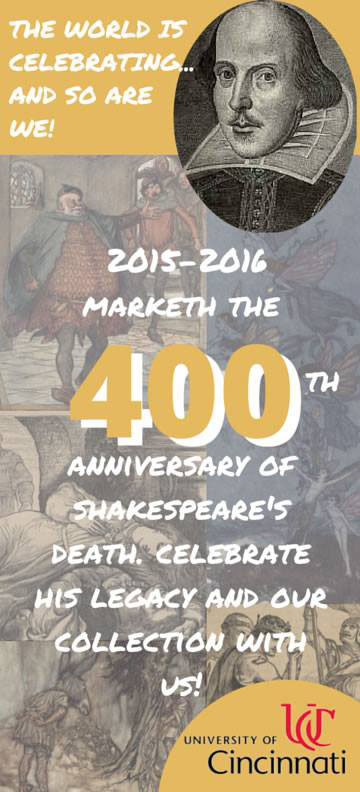 We need your help! The Archives and Rare Books Library is expanding its Shakespeare holdings as part of the 2016 quadricentennial . In our effort to document and preserve the heritage of Shakespeare productions in the greater Cincinnati area over the past two centuries, we’re building an archival collection of local Shakespeare play programs. It doesn’t matter if they are from 1902 or two days ago. They can be programs from performances by CCM, high schools, professional theater groups, or the couple next door who are forever emoting on Romeo and Juliet. It doesn’t matter! The only requirement we have is that the performance took place somewhere in the tri-state.
We need your help! The Archives and Rare Books Library is expanding its Shakespeare holdings as part of the 2016 quadricentennial . In our effort to document and preserve the heritage of Shakespeare productions in the greater Cincinnati area over the past two centuries, we’re building an archival collection of local Shakespeare play programs. It doesn’t matter if they are from 1902 or two days ago. They can be programs from performances by CCM, high schools, professional theater groups, or the couple next door who are forever emoting on Romeo and Juliet. It doesn’t matter! The only requirement we have is that the performance took place somewhere in the tri-state.
Please mail your submissions to the Archives and Rare Books Library, P.O. Box 210113, Cincinnati, OH 45211-0113 or drop them by our library on the 8th floor of Blegen Library. If you have any questions, just contact us via email (archives@mail.uc.edu) or give us a call Monday through Friday, 8-5, at (513) 556-1959.
Thank you all so much for following our celebration, and a special thanks to anyone who can contribute. We can’t wait to see the wonderful programs you have in store for us! To learn more about our Shakespeare commemoration, have a look at our web page, http://libapps.libraries.uc.edu/exhibits/shakespeare400/.

